July 2021
Posted: 7/26/2021 1:56:23 PM
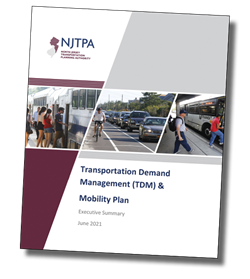 The NJTPA has released a Transportation Demand Management (TDM) and Mobility Plan that identifies regional policies and strategies to increase traveler choices while also minimizing the negative impacts of single-occupant vehicle (SOV) travel on congestion, air quality, and safety.
The NJTPA has released a Transportation Demand Management (TDM) and Mobility Plan that identifies regional policies and strategies to increase traveler choices while also minimizing the negative impacts of single-occupant vehicle (SOV) travel on congestion, air quality, and safety.
The plan and its recommendations helped inform policies in NJTPA’s updated long range transportation plan, Plan 2050: Transportation, People, Opportunity.
Prior to the COVID-19 pandemic over 2.2 million or 69 percent of the region’s residents drove to work alone, making SOVs the most common commute mode choice, according to the TDM plan. Transit was the second most common commute mode choice with nearly 500,000 riders (13 percent of commuters).
Reducing reliance on SOVs would make the transportation system operate more efficiently, provide more options for people who cannot or choose not to drive, and reduce the climate impacts of driving. Regionally, according to the research for the TDM plan, congestion adds an average of 17 seconds per mile to auto trips.
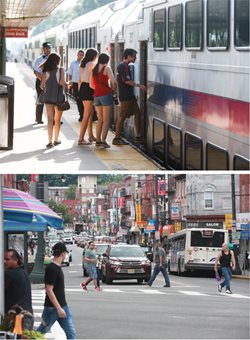 TDM encompasses a host of strategies and programs, including: monetary incentives; carsharing or bike sharing; dedicated bus lanes; protected bike lanes; reducing parking requirements; working with employers to host carpools or vanpools or provide incentives to take transit; public transit improvements, such as accurate real-time arrival information, reduced fares for some trips, and easy to use wayfinding; and marketing the benefits of reducing driving.
TDM encompasses a host of strategies and programs, including: monetary incentives; carsharing or bike sharing; dedicated bus lanes; protected bike lanes; reducing parking requirements; working with employers to host carpools or vanpools or provide incentives to take transit; public transit improvements, such as accurate real-time arrival information, reduced fares for some trips, and easy to use wayfinding; and marketing the benefits of reducing driving.
The NJTPA has supported these and other strategies, particularly through its work with the state’s eight transportation management associations. Preparation of the TDM plan included investigation of over 50 strategies, including those that are demand-focused (reducing the demand for drive-alone trips) as well as supply-focused (increasing the supply of sustainable alternatives to driving). These were narrowed to the following six high priority strategies with input from NJTPA subregions and regional stakeholders:
- Institutionalize a complete streets approach to designing, building, and maintaining roads, which has the potential to increase the convenience and safety of walking and biking, thereby reducing the need for vehicle trips.
- Help municipalities integrate sustainable and equitable transportation initiatives into land use and development decisions.
- Support telework and teleservices, which reduce trips and can increase access to employment, healthcare, and social services.
- Create a “Mobility on Demand” platform to enhance traveler information, trip planning, and payments across multiple services.
- Fund first/last mile solutions including transit shuttles, car services, micromobility systems, and bicycle/pedestrian networks connecting people from home to transit or from their transit stop to their workplace or destination.
- Enhance NJRideshare.com, New Jersey’s carpool and vanpool matching system to better meet the needs of commuters and non-commuters alike.
The plan provides implementation guidance for each of the six selected strategies. The TDM plan is on the NJTPA website.
Posted: 7/26/2021 1:29:28 PM
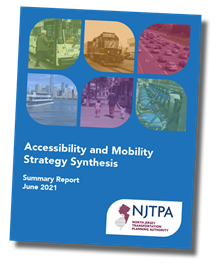 The NJTPA recently completed the Accessibility and Mobility Strategy Synthesis study, which provides a detailed assessment of the region’s varied transportation needs–including equity considerations–and identifies potential strategies for improvements. The study is an update to the region’s federally mandated Congestion Management Process (CMP).
The NJTPA recently completed the Accessibility and Mobility Strategy Synthesis study, which provides a detailed assessment of the region’s varied transportation needs–including equity considerations–and identifies potential strategies for improvements. The study is an update to the region’s federally mandated Congestion Management Process (CMP).
The study focused on accessibility, which refers to travelers reaching desired destinations within a reasonable time and cost; and mobility, which addresses the movement of people and goods on the transportation network and how well that system provides safe, reliable, and efficient travel.
Some needs identified in the study are shared across the region, such as addressing roadway reliability, improving bicycle and pedestrian safety and infrastructure, and alleviating congestion on freight corridors. Other needs are more tied to geography–varying according to housing, commuting and other features in urban, suburban, and rural areas.
From an equity standpoint, the study highlights issues such as access to private vehicles and concentrations of minority populations far from some suburban job centers.
A series of technical reports provide more detailed information related to each step of the study process:
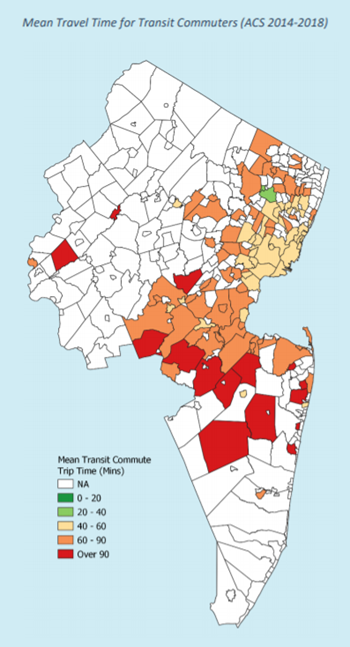 Objectives and Performance Measures—Identifies three overarching objectives—improving accessibility to destinations, ensuring equitable access for all and enhancing travel reliability for all modes—as well as supporting objectives and performance measures.
Objectives and Performance Measures—Identifies three overarching objectives—improving accessibility to destinations, ensuring equitable access for all and enhancing travel reliability for all modes—as well as supporting objectives and performance measures.
Needs Assessment—Includes maps, tables, and descriptions of identified needs. While “needs” generally reflect performance gaps or problems identified by regional stakeholders, they may also be characterized as “opportunities” for improvement.
Equity Assessment—Explores mobility and accessibility outcomes for different socio-demographic groups in the 13-county NJTPA region. These include both environmental justice (minority and/or low-income) populations and other groups (e.g., seniors, persons with disabilities, limited English proficiency). A Transportation Equity Survey was also conducted to gather stakeholder perspectives.
Strategy Identification and Prioritization—Identifies a menu of possible strategies organized under eight categories. The document describes recommended steps for prioritizing strategies, matching needs to strategies and implementing them. It includes a matrix to help partner organizations identify possible strategies to address specific types of needs.
Findings in these reports are highlighted in a Summary Report. A CMP Strategy Profiles companion document provides a resource for partner agencies to support strategy implementation. This includes an array of effective and economical strategies for planners, engineers, and elected officials to consider as they seek solutions for local transportation challenges.
The reports are available at on the study webpage. Information on Congestion Management can be found on the CMP page.
Posted: 7/16/2021 11:42:08 AM
NJTPA and other Metropolitan Planning Organizations (MPOs) can take a leadership role in moving climate change resiliency planning beyond basic research about vulnerabilities to more detailed action plans tailored to local conditions. That was a key insight Anne Choate, Vice President of Energy, Environment, and Infrastructure at ICF, offered in a presentation at the NJTPA Board of Trustees’ July meeting.
Choate said studies of transportation resiliency needs around the country funded by the Federal Highway Administration (FHWA) over the last decade have yielded increasing knowledge to guide more “granular” and “place-based” investigations in each region. Her firm, ICF, has consulted on these efforts at all levels of government.
She said New Jersey has faced particular challenges. A 2020 study by the New Jersey Department of Environmental Protection found that by mid-century sea levels could rise by 1.4 feet and precipitation could increase 4 to 11 percent in the state. That will exacerbate already severe flooding in many areas. It will be accompanied by more frequent heat waves of longer duration, with increasing health impacts for seniors and other vulnerable populations.
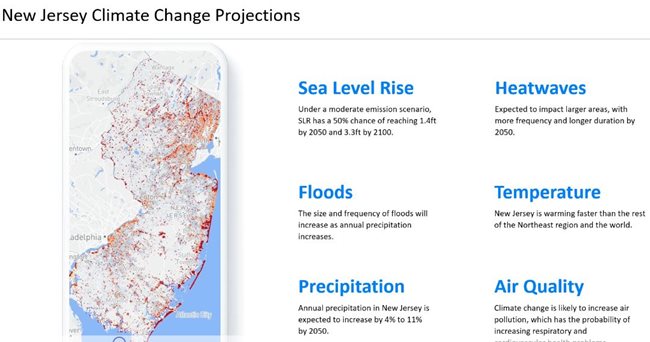
She emphasized that the success of transportation resiliency efforts depends on recognizing the “interconnected and interdependent” nature of systems affected by climate change, including energy, water, health, natural resources and more. This, she said, avoids creating “adaptation islands.”
She said NJTPA was an early leader in climate change resiliency planning through its participation in FHWA-sponsored studies, including exploring the impacts of Hurricane Irene and Superstorm Sandy and later identifying vulnerabilities in the Passaic River basin area. Lessons learned from these and other efforts, she said, will be reflected in guidebooks FHWA will be issuing on integrating resiliency into the planning process and in asset management.
MPOs, she said, are particularly important to resiliency efforts because climate impacts cross jurisdictional boundaries and touch many interests. She said they have a “unique ability” to convene diverse stakeholders, coordinate on a regional basis and balance competing concerns such as equity, mobility, access and health. If done right, she said, resiliency planning provides “opportunities for synergy where you can achieve multiple goals.”
To gain support of the public and key officials, she said, MPOs can help build the “business case” for resiliency planning. She gave the example of a detailed economic analysis done of proposed stormwater upgrades in Miami. While the improvements are costly, conducting the analysis enabled planners to have conversations with developers and others about their potential benefits “with real hard data in their back pockets.”
NJTPA First Vice Chair John Bartlett, a Passaic County Commissioner, expressed agreement with the approach, noting that for resiliency “inaction can cost more than action.” He thanked Choate for her presentation.
A recording of the presentation is available on the NJTPA YouTube Channel
Posted: 7/6/2021 7:00:00 AM
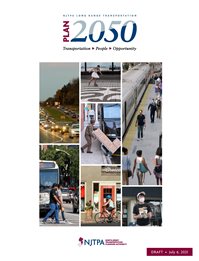 Transportation. People. Opportunity.
Transportation. People. Opportunity.
Those are the themes that the NJTPA’s draft long range transportation plan (LRTP) focuses on. The plan, which has a horizon year of 2050, is one of three core documents that the NJTPA is seeking public comment on through August 4.
The other documents are the Fiscal Year 2022-2025 Transportation Improvement Program (TIP), which is a four-year fiscally constrained agenda of transportation improvement projects drawn from the LRTP, and the Air Quality Conformity Determination, a federally required analysis of the LRTP and TIP used to demonstrate the funded projects, taken together, meet the standards set forth in New Jersey’s State Implementation Plan.
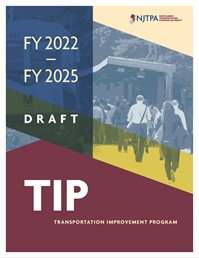 In order to be eligible for federal funds, proposed projects must be approved by the NJTPA Board for inclusion in the TIP, which is updated every two years. The FY 2022-2025 TIP contains 263 projects and programs totaling $11.5 billion.
In order to be eligible for federal funds, proposed projects must be approved by the NJTPA Board for inclusion in the TIP, which is updated every two years. The FY 2022-2025 TIP contains 263 projects and programs totaling $11.5 billion.
A virtual public meeting is being held July 27 from 4 to 7 p.m. to provide information about the products and to gather input. The public is invited to attend any time during the three-hour event. People interested in participating can review the drafts, provide feedback and register for the event at https://njtpa.org/publiccomment.
Plan 2050: Transportation, People, Opportunity, is a vision for investing wisely to improve roads, rail and other infrastructure to meet the needs of transportation users and support the regional economy.
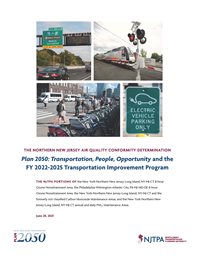 The plan incorporates input gathered through extensive public and stakeholder outreach. It was developed under the direction of the NJTPA Board of Trustees in close collaboration with partner agencies, including member city and county “subregions,” the New Jersey Department of Transportation (NJDOT), NJ TRANSIT, the Port Authority of New York & New Jersey (PANYNJ), the state’s eight Transportation Management Associations (TMAs), and the Together North Jersey (TNJ) consortium, among others.
The plan incorporates input gathered through extensive public and stakeholder outreach. It was developed under the direction of the NJTPA Board of Trustees in close collaboration with partner agencies, including member city and county “subregions,” the New Jersey Department of Transportation (NJDOT), NJ TRANSIT, the Port Authority of New York & New Jersey (PANYNJ), the state’s eight Transportation Management Associations (TMAs), and the Together North Jersey (TNJ) consortium, among others.
The plan considers disruptors experienced in 2020 and 2021 — the need to provide transportation to essential workers during the pandemic, growth in e-commerce, shifts to telework, a widespread embrace of walking and biking and opening streets to outdoor dining and other creative uses. It also considers ways to better address the mobility needs of minority and low income communities and anticipated disruptors, particularly advances in transportation technology, like driverless cars and an increased use of electric and alternative fuel vehicles, and the need to mitigate climate change.
In addition to its planning products, the NJTPA also seeks comments on NJDOT’s draft Fiscal Year 2022-2031 Statewide Transportation Improvement Program (STIP). The STIP is the federally required compilation of TIPs from the NJTPA and the state’s two other Metropolitan Planning Organizations (Delaware Valley Regional Planning Commission and South Jersey Transportation Planning Organization).
All of the documents are on file at New Jersey Library Network libraries in the NJTPA region and available at https://njtpa.org/publiccomment. Comments can be submitted via email to [email protected] or by calling (862) 800-7457 (English) or (862) 800-7239 (Español) and leaving a voicemail.